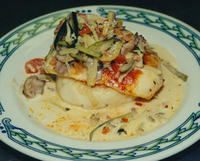

DUBLIN, Ireland -- One day into a motor tour of Ireland in search of something to overcome the negative stereotypes about Irish food and I was stumped.
I was here in the capital city, sitting with a traveling companion in the bar of the beautifully converted
Clontarf Castle, site of one of the epic battles of the ancient Irish warrior king Brian Boru. We were trying to figure out where to find the best place for local food.
The hotel bell captain seemed a logical person to consult.
"Well," he said in all seriousness, "it depends on what sort of local food you're looking for. The best in the city is Italian, Thai or Chinese."
That was several years ago, and it's even truer today unless you're so far off the beaten path you're creating a new one. The difference is that the New Irish Cuisine, as it is capitalized in most Irish publications, also has begun making inroads into popular taste.
Much as I pride myself on my nearly 100 percent Irish heritage, I cringe -- as does my aorta -- when I think of some of the dishes that once were typically representative of Irish cuisine.
Finnan Haddie, a smoked fish and mashed potato dish. Dublin Coddle, featuring flour-coated pork sausage fried in bacon fat then cooked in cider with onions and potatos. Bacon and Egg Pie, which includes a half-dozen eggs and four ounces of lard. Carrageen Pudding, which is primarily dried seaweed and whipped heavy cream. Toad in the Hole, a bacon-wrapped sausage baked in mustard dough and covered in gravy. And endless platters and bowls of potatoes baked, mashed, fried, steamed, boiled, grilled, sauteed and whatever else one could think of to do with them.
But that was then. This is now, and my how things have changed.
Irish restaurants and modern Irish families are relying on such things as chicken, salmon, monkfish, lamb and vegetarian dishes in ever-increasing amounts, although the ubiquitous and versatile potato retains its place of honor in the Irish kitchen.
Dishes tend to be more of the "spa cuisine" variety, with less reliance on heavy creams and fats and more exploitation of the island's abundance of fresh produce. Some of the dishes still look heavy -- like the dishs shown above, cod sorrel (top) and colcannon (bottom) -- but light, alternative ingredients lessen the impact.
Ireland once had plenty of people and no money. Now, thanks to its leadership among European nations in the technological revolution, it has plenty of money and no people. To attract new ones and hold on to the ones it has, developing a modern, appealing cuisine has become an important task.
The island's two national food trade groups,
Bord Bia (Irish Food Board) and
Trade International Northern Ireland, are helping market Irish products worldwide and soliciting foreign investment in the industry under the promotional title "Ireland: The Food Island."
Tourists are being directed to culinary destination spots throughout the country, especially to the southern port city of Kinsale, a picturesque spot that has emerged as the country's gastronomic capital.
As Muirish Kennedy, Bord Bia's client services director, told
Irish Connections magazine, "Ireland has changed drastically. ... The young sector is very much the driving force. The food companies here were started in the last 15 years. It's a young new generation that is much more aggressive, much more aware."
There is rarely a question about the quality of Irish agricultural and livestock products. Willing consumers abroad buy 90 percent of Ireland's annual output. The knock has been on what Irish cooks have done with those products at home.
Until the recent economic upsurge, dining out regularly was a rarity in most parts of Ireland, with fewer than 25 percent of people doing it compared to about 70 percent in the U.S. That mindset, which tends to discourage culinary experimenta tion, was perpetuated in the lives of Irish expatriates around the world. Thus, to many people the likes of Toad in the Hole still exemplifies Irish cuisine.
Couple the experiences younger, adventuresome Irish have had in traveling abroad with their higher wages and more disposable income and the demand for better food becomes even clearer.
The appetite for things Irish can be seen in a number of areas beyond industry trade shows. At the bookstores, for example, you can find titles that put to rest the foods of the famine and poverty years. Instead, we find "Elegant Irish Cooking: Recipes from the World's Foremost Irish Chefs," compiled by the noted Irish master chef Noel C. Cullen, now professor of culinary arts at Boston University. And, "The New Irish Table," a collection of recipes from restaurant and home cooks edited by Margaret M. Johnson who has written on Irish food for such newspapers as the Los Angeles Times and the
Irish Echo.
And, while they don't have the reputations of such world-renowned culinary schools as the Cordon Bleu in France or the Culinary Institute of America, Irish cooking schools are enjoying a growing reputation.
Noted chef Darina Allen's Ballymaloe Cooking School, operated at her
Ballymaloe House Hotel in County Cork, is perhaps the brightest example. It has been the catalyst for several well-received cookbooks and the work of hundreds of graduates who took advantage of the organic farm and extensive gardens on the property.
The world of New Irish Cuisine is not limited to the Republic of Ireland. In Northern Ireland, where tourism is comparatively strong despite the continued violence in an around Belfast, 70 miles from there in County Fermanagh the
Belle Isle School of Cookery is a big draw for residential or one-day classes.
It's situated on a wooded island in Lough Erne, a rural lake that is home to 11 islands owned by the same nobleman, the Duke of Abercorn.
To prove some things about Irish eating and drinking habits never change, the school's brochures brag about its proximity to many attractions -- particularly the
Old Bushmills Distillery, at age 396 the oldest licensed distillery in the world, where the renowned Bushmills whiskey is produced.
ON THE WEB•
On the Road In Search of My Darby Duck•
Dowd's Guides
 If your airline flight is delayed this winter because of icy runways, you may have Saskatchewan potash miners to thank for much of the inconvenience.
If your airline flight is delayed this winter because of icy runways, you may have Saskatchewan potash miners to thank for much of the inconvenience.











